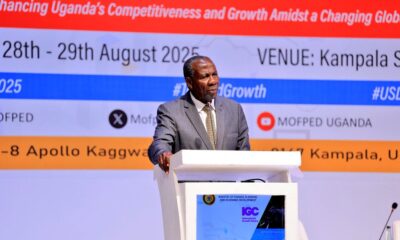Economy
Uganda Unveils Ambitious Five-Year Strategy to Reform Public Financial Management
The Government of Uganda has officially launched a transformative Public Financial Management (PFM) Reform Strategy for 2025–2030, aiming to overhaul how public funds are mobilised, allocated, and utilised—placing transparency, efficiency, and equity at the heart of national development.
The five-year strategy, unveiled in Kampala, is poised to significantly improve service delivery, strengthen institutional accountability, and empower local communities to benefit more directly from government spending.
Representing Prime Minister Robinah Nabbanja at the event, State Minister for Planning Amos Lugoloobi emphasised the government’s commitment to making every shilling count.
“This strategy reaffirms our obligation to manage public resources transparently and ensure that every shilling raised is used to improve the lives of Ugandans,” said Lugoloobi. “The budget should not be a document for accounting purposes only; it must be a tool of transformation.”
The new strategy builds on ongoing reforms and aligns with Vision 2040 and the Fourth National Development Plan (NDPIV). It is anchored on six strategic pillars: Enhanced domestic revenue mobilisation. Expenditure control and fiscal discipline. Digitisation of financial systems. Improved budget execution and reporting. Strengthened institutional capacity. Better service delivery outcomes
The government plans to shift the focus from mere budgetary outputs to tangible results in key sectors such as education, health, and water. “A health centre must not only be built—it must have medicine and qualified staff to serve,” Lugoloobi stressed, in a direct call for meaningful use of public funds.
Ramathan Ggoobi, the Permanent Secretary and Secretary to the Treasury, echoed the urgency of Uganda funding its own development sustainably.
“This strategy identifies opportunities for Uganda to grow faster, smarter, and more equitably,” said Ggoobi. “We must create jobs, build strong communities, and widen the tax base while ensuring that foreign direct investment complements—not compromises—our national revenue interests.”
Ggoobi singled out agro-industrialisation, tourism, mineral beneficiation, and science, technology, and innovation as sectors central to driving inclusive economic growth.
He also highlighted the comprehensive and inclusive process that shaped the reform blueprint. Key assessments—including the 2023 Public Investment Management Assessment and the 2024 Public Expenditure and Financial Accountability (PEFA) Report—formed the foundation of the strategy.
“This reform process has been shaped by evidence, inclusivity, and a shared national vision,” Ggoobi stated. “We thank all our stakeholders and development partners who contributed meaningfully to this effort.”
A central feature of the strategy is the investment in institutional capacity and human capital. Ggoobi stressed that successful implementation hinges on capable and committed public servants. “No reform can succeed without skilled professionals and motivated teams. Accounting officers must take full ownership and lead by example,” he noted.
The government is also expected to intensify efforts to deploy digital financial systems, tighten expenditure control, and enhance transparency in public procurement and reporting.
As Uganda enters the next phase of its development journey, the 2025–2030 PFM Reform Strategy signals a bold commitment to efficient governance and the long-term prosperity of its people.
Observers say if implemented effectively, the strategy could be a turning point for Uganda’s fiscal policy—transforming the national budget from a routine administrative tool into a true engine for inclusive growth.
Comments

























